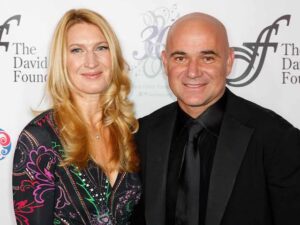
In a historic and emotionally charged ceremony held today at Munich’s Olympic Park, Germany unveiled a towering living bronze statue of tennis legend Steffi Graf, marking what is believed to be the first-ever monumental tribute of this kind to a female tennis player anywhere in the world.
Towering at over 5 meters, the statue is no ordinary sculpture—it is described as a “living bronze monument,” designed with cutting-edge kinetic technology that allows subtle, life-like movement. With a timeless smile, Graf is depicted mid-celebration: one hand proudly raising the Wimbledon Trophy, the other gripping a bronze tennis racket, forever captured in the moment that defined an era.
Crowds gathered in the thousands as the statue was revealed beneath a golden silk covering. As the bronze figure came into full view, the crowd erupted in applause, many holding banners that read, “Danke, Steffi”.
German President Frank-Walter Steinmeier, who was present at the unveiling, praised Graf’s contribution to not just German sport but global athleticism.
“Steffi Graf redefined what it meant to be a champion. Today, we honor not only her records, but her legacy, her humility, and her inspiration to generations of athletes—men and women alike.”
🏆 A Legacy Carved in Bronze
The base of the statue is etched with Graf’s unparalleled achievements:
- 22 Grand Slam Titles
- 1 Calendar Year Grand Slam (1988)
- 2 Olympic Gold Medals
- 377 Weeks as World No. 1 (Longest in WTA history)
Her historic Golden Slam in 1988, when she won all four majors and Olympic gold in a single calendar year, remains unmatched to this day—cementing her as one of the greatest athletes in history.
Appearing visibly moved, Steffi Graf, now 56, attended the ceremony with her husband, fellow tennis legend Andre Agassi, and their children. She took the stage briefly to speak:
“I never played for monuments. I played for the love of the sport, and for the joy it gave me. But this… this is beyond anything I could have imagined. Thank you, Germany. Thank you, tennis.”
She later joked, “Now every time someone walks through this park, they’ll have to walk past my backhand.”
Although born in Mannheim and raised in Brühl, Munich was selected for its rich sporting history and international visibility. The statue is placed at the Olympic Park, not far from where athletes from around the world competed during the 1972 Summer Olympics. Organizers noted that the location was chosen to symbolize “Germany’s enduring athletic spirit and its greatest champions.”
What makes this unveiling particularly groundbreaking is the gender milestone. While statues of male sports heroes line stadiums across the globe, very few female athletes—let alone tennis players—have received monumental public recognition of this scale.
“This isn’t just a statue. It’s a message to girls around the world: greatness is not just allowed—it’s expected,” said Sabine Reuter, head of the German Women in Sport Federation.
Tributes poured in from fellow tennis legends including Serena Williams, Martina Navratilova, Roger Federer, and Novak Djokovic. Social media exploded with admiration, with hashtags like #SteffiEternal, #LivingLegend, and #BronzeGraf trending globally.

From the courts of Wimbledon to the hearts of millions, Steffi Graf has always stood tall. Today, she stands taller than ever—immortalized in bronze, beating heart or not, forever in motion, forever a champion.









